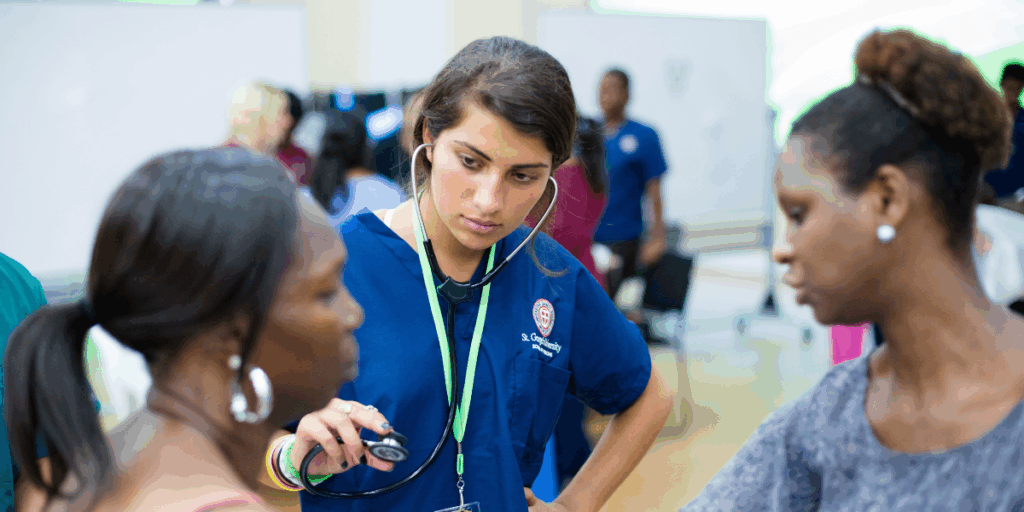When it comes to keeping patients breathing comfortably, few specialties are as vital as pulmonology. Pulmonologists serve as the medical detectives of the respiratory system, diagnosing and treating conditions ranging from asthma to more complex illnesses such as lung cancer. Often on the frontlines in the ICU, when patients are struggling to breathe, their role is both challenging and deeply impactful.
At St. George’s University (SGU), students preparing for careers in medicine gain exposure to specialties like pulmonology, combining problem-solving, technology, and patient care into a deeply rewarding career path. This guide explores the essential steps of how to become a pulmonologist.
What does a pulmonologist do?
Pulmonologists specialize in diseases of the lungs and respiratory tract. In clinic settings, they work with patients to manage long-term conditions like asthma, create personalized care plans, and run breathing tests that measure how well the lungs are working. In hospitals, they are often part of life-saving teams, stepping in when patients are struggling to breathe. They may perform procedures like using a small camera to look inside the airways, a bronchoscopy, or a thoracentesis, the draining excess fluid around the lungs.
Many pulmonologists also train in pulmonary and critical care medicine, which means they not only treat breathing problems but also care for people who are critically ill in intensive care units. This combination of expertise makes them a vital part of emergency and ICU teams, where every decision can make a life-changing difference.
Why do med students pursue pulmonology?
The field of pulmonology attracts new physicians every year for many reasons. One of the main draws of the specialty is its unique blend of diagnostic challenge, procedural skill, and patient connection.
Nader Mahmood, MD ’08, is an SGU grad and an internal medicine clinical assistant professor at St. Mary’s General Hospital/Saint Clare’s Hospital, one of SGU’s 75+ affiliated hospitals and clinical sites. He is also a pulmonologist at North Jersey Pulmonary Associates.
According to Dr. Mahmood, pulmonary medicine fascinates him because of its “diverse and dynamic nature. The specialty involves addressing critical, often life-threatening conditions while also focusing on chronic care.”
Dr. Mahmood’s own journey from SGU medical student to pulmonologist, and now a clinical faculty member, illustrates the growth, leadership, and fulfillment the specialty can offer. His experiences provide valuable insight for students seeking to understand how to become a pulmonologist.
“I was fortunate during my clinical rotations at SGU to encounter exceptional mentors who nurtured my appreciation for pulmonary medicine. Their guidance and expertise deepened my understanding of the field and inspired me to pursue it with passion,” he shares.
Another SGU clinical faculty member, Dr. Sharad Dass, is a critical care pulmonologist and the director of medical education at O’Connor Hospital. For Dr. Dass, pulmonology is a rewarding specialty that focuses on much more than just the lungs.
“In critical care, you kind of have to be the jack of all trades. You have to understand what can cause a critical situation. It could be different parts of the body, not just the lungs. It could be the heart, the endocrine system, the GI system, etc.,” he explains.
“So, you have to be able to care for patients that may have developed a critical/life-threatening illness from any organ system in the body. It can be stressful, but I like the level of energy in the intensive care.”
How to become a pulmonologist
Pulmonology requires years of rigorous training, intellectual curiosity, and a commitment to lifelong learning. For those with an interest in respiratory health, critical care, and patient advocacy, it can be a deeply rewarding career.
So, how long does it take to become a pulmonologist? Here’s a clear roadmap for those curious about how to become a pulmonologist.
Earn your MD
Begin by earning your medical degree from an accredited institution, such as St. George’s University School of Medicine. This typically follows completion of a bachelor’s degree (or equivalent pre-med coursework) and a successful performance on the MCAT or equivalent entry exam. Medical school generally takes four years, two years in Basic Sciences and two years in clinical rotations, where you’ll have opportunities to explore specialties like internal medicine and critical care.
Complete an internal medicine residency
After medical school, you’ll enter a three-year internal medicine residency. This is where you’ll gain exposure to a variety of patient cases, including respiratory illnesses, both in outpatient clinics and hospital wards. Rotations in the ICU are especially valuable for future pulmonologists. These rotations are a critical step in learning how to become a pulmonologist.
Pursue fellowship training in pulmonary and critical care medicine
Following residency, most aspiring pulmonologists complete a three-year fellowship in pulmonary and critical care medicine. This advanced training covers both outpatient respiratory medicine and intensive care management, preparing you for complex cases such as mechanical ventilation, interstitial lung disease, and pulmonary hypertension.
Obtain board certification
Once fellowship is complete, you can take specialty board exams to become board certified in pulmonary disease and often critical care medicine. This certification demonstrates your expertise and commitment to high standards of care.
Tips for medical students interested in pulmonology
Pulmonology is a dynamic specialty that blends critical care, long-term patient management, and rapidly advancing technologies. For medical students considering this path, early preparation can help build both competence and confidence. Below are some practical tips to guide you as you explore a career in pulmonary medicine.
- Seek early exposure: Choose clinical rotations with strong ICU or respiratory care components to confirm your interest and strengthen your resume.
- Find mentors: Connect with faculty or attending physicians in pulmonary medicine for career guidance, shadowing opportunities, and research involvement.
- Sharpen your communication skills: Pulmonologists often treat patients with chronic, complex conditions, so explaining treatment plans clearly is essential.
- Stay current: Pulmonology evolves rapidly with advances in imaging, minimally invasive procedures, and therapies. Regularly engage with journals, conferences, and professional societies.
A career that helps the world breathe better
Pulmonology is more than a specialty; it’s a calling to safeguard one of life’s most essential functions. For medical students ready to combine science, skill, and compassion, learning how to become a pulmonologist can open the door to a fulfilling and impactful career in pulmonary medicine.
From applying to medical school to earning board certification, explore our free guide, Journey to MD. Discover how SGU can be the starting point for your medical career.


